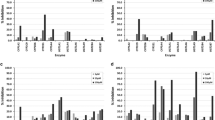Summary
Tacrolimus is extensively metabolized by the cytochrome P-450 system. Hepatic metabolic phase I reactions of tacrolimus include mainly demethylation and/or hydroxylation. No valid data have been published on phase II pathways (glucuronide- or sulfo-conjugation). In order to investigate these pathways, different β-glucuronidase/sulfatase enzyme preparations were used to hydrolyse the conjugates potentially present in human bile extracts. Two analytical methods were used: a non-specific method, MEIA, and a specific combined HPLC/MEIA method. The influence of the extraction pH was investigated. After β-glucuronidase hydrolysis and extraction at pH 5, tacrolimus concentrations, obtained either from HPLC-MEIA or MEIA, always appeared significantly higher, suggesting the presence of glucuronides in the bile. When the extraction was performed at pH 1.5, only the HPLC-MEIA concentrations appeared higher after hydrolysis. MEIA concentrations obtained before and after hydrolysis were similar. These data are consistent with the fact that glucuronides are extracted at pH 1.5 but not at pH 5 and suggest first that, without hydrolysis, the extracted glucuronides are separated from the tacrolimus fraction in the HPLC-MEIA procedure, and second, that the glucuronides are cross-detected by the monoclonal antibody in the immunoassay. From these data, it is concluded that clues have been found, suggesting the presence in human bile of tacrolimus glucuronides, which cross-react with the monoclonal antibody, provided they are extracted in the sample tested.
Similar content being viewed by others
References
Venkataramanan R., Jain A., Cadoff E. et al. (1990): Pharmacokinetics of FK 506: preclinical and clinical studies. Transplant. Proc., 22 (suppl 1) 52–56.
Christians U., Kruse C., Kownatzki R. et al. (1991): Measurement of FK 506 by HPLC and isolation and characterization of its metabolites. Transplant. Proc., 23 940–941.
Shah I.A., Whiting P.H., Omar G., Thomson A.W., Burke M.D. (1991): Effects of FK 506 on human hepatic microsomal cytochrome P-450-dependent drug metabolism in vitro. Transplant. Proc., 23, 2783–2785.
Sattler M., Guengerich F.P., Yun C.H., Christians U., Sewing F.K. (1992): Cytochrome P-450 3A enzymes are responsible for biotransformation of FK 506 and rapamycin in man and rat. Drug Metab. Dispos., 20, 753–761.
Stiff D.D., Venkataramanan R., Tara T.N.V. (1992): Metabolism of FK 506 in differentially induced rat liver microsomes. Res. Commun. Chem. Pathol., 78, 121–124.
Vincent S.H., Karanam B.V., Painter S.K., Chiu S.H.L. (1992): In vitro metabolism of FK-506 in rat, rabbit, and human liver microsomes: identification of a major metabolite and of cytochrome P450 3A as the major enzymes responsible for its metabolism. Arch. Biochem. Biophys., 294, 454–460.
Christians U., Braun F., Kosian N. et al. (1991): High performance liquid chromatography/mass spectrometry of FK 506 and its metabolites in blood, bile and urine of liver grafted patients. Transplant. Proc., 23, 2741–2744.
Iwasaki K., Shiraga T., Matsuda H., Nagase K. (1995): Identification and biological activities of the metabolites oxidised at multiple sites of FK506. Drug Metab. Dispos., 23, 28–34.
Lhoëst G., Maton N., Verbeeck R. (1993): Isolation and identification of a novel isomerized epoxide metabolite of FK-506 from erythromycin-induced rabbit liver microsomes. Drug Metab. Dispos., 21, 850–854.
Venkataramanan R., Swaminathan A., Prasad T. et al. (1995): Clinical pharmacokinetics of tacrolimus. Clin. Pharmacokinet., 29, 404–430.
Miners J.O. Lillywhite K.J., Yoovathaworn K., Pongmarutal M., Birkett D.J. (1990): Characterization of paracetamol UDP-glucuronosyltransferase activity in human liver microsomes. Biochem. Pharmacol., 40, 595–600.
George A., Hazelton, Curtis D., Klaassen (1988): UDP-Glucuronosyltransferase activity toward digitoxigenin-monodigitoxoside. Drug Metab. Dispos., 16, 30–36.
Firdaous I., Hassoun A., Otte J.B. et al. (1995): HPLC-Microparticle enzyme immunoassay specific for tacrolimus in whole blood of hepatic and renal transplant patients. Clin. Chem., 41, 1292–1296.
Kroemer H.K., Klotz U. (1992): Glucuronidation of drugs. A re-evaluation of the pharmacological significance of the conjugates and modulating factors. Clin. Pharmacokinet., 23 292–310.
Author information
Authors and Affiliations
Rights and permissions
About this article
Cite this article
Firdaous, I., Vėrbeeck, R.K., Hassoun, A. et al. Excretion of tacrolimus glucuronides in human bile. European Journal of Drug Metabolism and Pharmacokinetics 22, 217–221 (1997). https://doi.org/10.1007/BF03189810
Received:
Issue Date:
DOI: https://doi.org/10.1007/BF03189810




